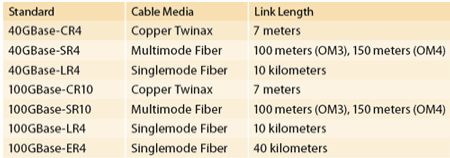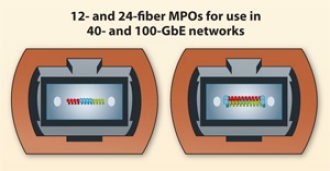In 2002, the IEEE ratified the 802.3ae standard for 10 GbE over fiber using duplex fiber links and vertical cavity surface emitting laser (VCSEL) transceivers. Most 10 GbE applications use duplex LC style connectors where one fiber transmits and the other receives. Standards efforts aimed at finding a cost-effective method to support next-generation speeds of 40 and 100 Gbps, and in 2010, the IEEE ratified the 802.3ba standard for 40 and 100 GbE. Similar to how transportation highways are scaled to support increased traffic with multiple lanes at the same speed, the 40 and 100 GbE standards use parallel optics, or multiple lanes of fiber transmitting at the same speed. Running 40 GbE requires 8 fibers, with 4 fibers each transmitting at 10 Gbps and 4 fibers each receiving at 10 Gbps. Running 100 GbE requires a total of 20 fibers, with 10 transmitting at 10 Gbps and 10 receiving at 10 Gbps. Both scenarios call for using high-density multi-fiber MPO style connectors.
For 40 GbE, a 12-fiber MPO connector is used. Because only 8 optical fibers are required, typical 40 GbE applications use only the 4 left and 4 right optical fibers of the 12-fiber MPO connector, while the inner 4 optical fibers are left unused as shown in Figure 1.
To run 100 GbE, two 12-fiber MPO connectors can be used one transmitting 10 Gbps on 10 fibers and the other receiving 10 Gbps on 10 fibers. However, the recommended method for 100 GbE is to use a 24-fiber MPO style connector with the 20 fibers in the middle of the connector transmitting and receiving at 10 Gbps and the 2 top and bottom fibers on the left and right unused as shown in Figure 2.
Knowing that 40 and 100 GbE are just around the corner,and already a reality for some, many data center managers are striving to determine which physical layer solution will support 10 GbE today while providing the best, most effective migration path to 40 and 100 GbE. While many solutions on the market recommend the use of 12-fiber multimode trunk cables between core switches and the equipment distribution area in the data center, TE Connectivity recommends and offers a better standards-based migration path with the use of 24-fiber trunk cables.
The use of 24 fiber trunk cable between switch panels and equipment is a common-sense approach. In this scenario,24-fiber trunk cables with 24-fiber MPOs on both ends are used to connect from the back of the switch panel to the equipment distribution area. For 10 GbE applications, each of the 24 fibers can be used to transmit 10 Gbps, for a total of 12 links. For 40 GbE applications, which requires 8 fibers (4 transmitting and 4 receiving), a 24-fiber trunk cable provides a total of three 40 GbE links. For 100 GbE, which requires 20 fibers (10 transmitting and 10 receiving), a 24-fiber trunk cable provides a single 100 GbE link. Why is this more advantageous than using 12-fiber trunk cables? It all comes down to a better return on investment and reduced future operating and capital expense.
As mentioned previously, 40 GbE uses eight fibers of a 12-fiber MPO connector, leaving four fibers unused. When using a 12-fiber trunk cable, those same four fibers are unused. For example, three 40 GbE links using three separate 12-fiber trunk cables would result in a total of 12 unused fibers, or four fibers unused for each trunk.
With the use of 24-fiber trunk cables, data center managers actually get to use all the fiber and leverage their complete investment. Running three 40 GbE links over a single 24-fiber trunk cable uses all 24 fibers of the trunk cable. This recoups 33% of the fibers that would be lost with 12-fiber trunk cables, providing a much better return on investment. At 100 GbE which requires 20 fibers, a total of four fibers are left unused when using either two 12-fiber trunk cables or when using a single 24-fiber trunk cable. However, additional benefits come into play for 100 GbE and 12-fiber trunk cables are not the recommended configuration for 100 GbE. Figure 3 shows the ratio of 24-fiber trunk cables to corresponding connector types for each application.
The 10 Gigabit Interconnect Solution, like all of the planned migration designs, employs a 24-fiber optical trunk with a single MPO-type connector at each end. A trunk interfaces with the rear of a 24-fiber MPO cassette that breaks out the trunk fibers into twelve duplex LC connections at the front, supporting 24 fibers per cassette. This cassette resides in a time-proven RMG chassis which provides cable management and protection for both the MPOs at the rear and LC cords at the front. Fiberstore enclosures are stackable and available in 1, 2, and 4 RU versions and support up to 36 duplex LCs (72 fibers) per rack unit. They can be populated all at once, or added to or upgraded a cassette at a time in the future. The Fiberstore enclosure also supports high density 10 Gigabit cassettes, as well as 40 and 100 GbE versions, allowing an upgrade path by changing the cassette at the front and using existing and additional 24-fiber trunks at the rear.
High Density 10 Gigabit Fiber Cassettes also utilize 24-fiber MPO trunks and support connection from 40 Gigabit switch ports that have been remotely enabled as four 10 Gigabit independent paths. MPO based QSFP ports at the switch interface with a cassette at one end of the trunk, and a break-out cassette divides these signals into duplex LC pairs at the other end. MPO cassettes have two 24-fiber MPO connectors at the rear and six 8-fiber MPOs at the front. Each cassette supports distribution of six 40 Gigabit Ethernet paths, each containing four duplex 10 Gigabit links. These cassettes are connected via standard 24-fiber MPO trunks to a pair of two 2×12 LC duplex cassettes at the other end of the trunk. This pair of cassettes maintains fiber paths and polarity and provides proper fiber mapping from transmit at one end to receive at the other over a total of twenty-four 10 Gigabit paths.
Fiberstore supply 12, 24, 48, 72, 96 and 144 fiber core constructions with OM1, OM2, OM3 or OM4 fiber trunk cable, these trunk cable assemblies are composed of high quality LSZH jacketed fiber optic cables, connecting equipment in racks to MTP/MPO backbone cables. All kinds of MTP MPO cable length can be customized, meanwhile we also provide 40G/100G MTP/MPO cable solution.


